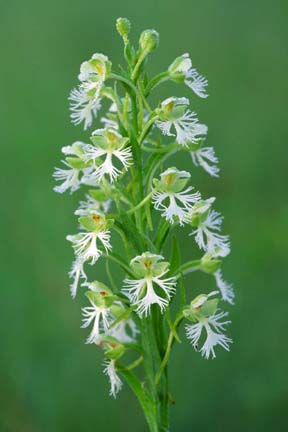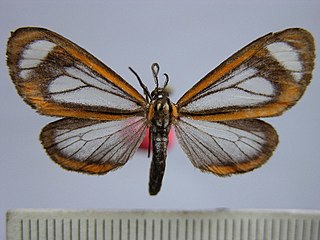Related Research Articles

The white-throated treecreeper is an Australian treecreeper found in the forests of eastern Australia. It is unrelated to the northern hemisphere treecreepers. It is a small passerine bird with predominantly brown and white plumage and measuring some 15 cm (6 in) long on average. It is insectivorous, eating mainly ants. Unlike treecreepers of the genus Climacteris, the white-throated treecreeper does not engage in cooperative breeding, and wherever it overlaps with species of that genus, it feeds upon much looser bark besides typically using different trees.

Platanthera leucophaea, commonly known as the prairie white fringed orchid or eastern prairie fringed orchid, is a rare species of orchid native to North America. It is a federally threatened species, protected since October 30, 1989 under the Endangered Species Act of 1973. In Canada, it has been listed endangered under Schedule 1 of the Species at Risk Act since 2005. In 2014, the International Union for Conservation of Nature assessed it as "least concern."

Berta Vogel Scharrer was an American scientist who helped to found the scientific discipline now known as neuroendocrinology.
Fulcrifera is a genus of moths belonging to the subfamily Olethreutinae of the family Tortricidae.

Gibbula leucophaea is a species of sea snail, a marine gastropod mollusk in the family Trochidae, the top snails.
Acrocercops leucophaea is a moth of the family Gracillariidae, known from Uttarakhand and Assam, India and Nepal. It was described by Edward Meyrick in 1919. The hostplants for the species include Lyonia ovalifolia and Engelhardia spicata.
Meza leucophaea, the margined missile, is a butterfly in the family Hesperiidae. It is found in Senegal, Guinea, Sierra Leone, Liberia, Ivory Coast, Ghana, Nigeria, Cameroon and Gabon. The habitat consists of forests.

Dysschema leucophaea is a moth of the family Erebidae first described by Francis Walker in 1854. It is found in Mexico, Honduras, Guatemala and Nicaragua.
Eucereon leucophaea is a moth of the subfamily Arctiinae. It was described by Francis Walker in 1855. It is found in the Brazilian states of Rio de Janeiro and São Paulo. Its status is not considered threatened.

Hyalurga leucophaea is a moth of the family Erebidae. It was described by Francis Walker in 1854. It is found in Venezuela and Peru.

Colobotheini is a tribe of longhorn beetles of the subfamily Lamiinae.

A squamulose lichen is a lichen that is composed of small, often overlapping "scales" called squamules. If they are raised from the substrate and appear leafy, the lichen may appear to be a foliose lichen, but the underside does not have a "skin" (cortex), as foliose lichens do. Squamulose lichens are composed of flattish units that are usually tightly clustered. They are like an intermediate between crustose and foliose lichens.

Colobothea is a genus of longhorn beetles of the subfamily Lamiinae.
Colobothea guatemalena is a species of beetle in the family Cerambycidae. It was described by Henry Walter Bates in 1881.
Colobothea andina is a species of beetle in the family Cerambycidae. It was described by Monné in 1993. It is known from Peru.
Colobothea cincticornis is a species of beetle in the family Cerambycidae. It was described by Schaller in 1783.
Colobothea subcincta is a species of beetle in the family Cerambycidae. It was described by Laporte in 1840. It is known from Brazil.

Cleora leucophaea is a species of moth in the family Geometridae. It is found in East Asia.
The Turkestani long-eared bat is a species of bat found in Asia. Though it was initially described in 1873 as a species, for many years it was considered synonymous with the desert long-eared bat, Otonycteris hemprichii. Recently, it was recognized as a distinct species once again.

Dasychira leucophaea, the pale-banded tussock moth, is a species of tussock moth in the family Erebidae. It is found in North America.
References
- ↑ BioLib.cz - Colobothea leucophaea. Retrieved on 8 September 2014.